Kejia Zhang
When Tokens Talk Too Much: A Survey of Multimodal Long-Context Token Compression across Images, Videos, and Audios
Jul 27, 2025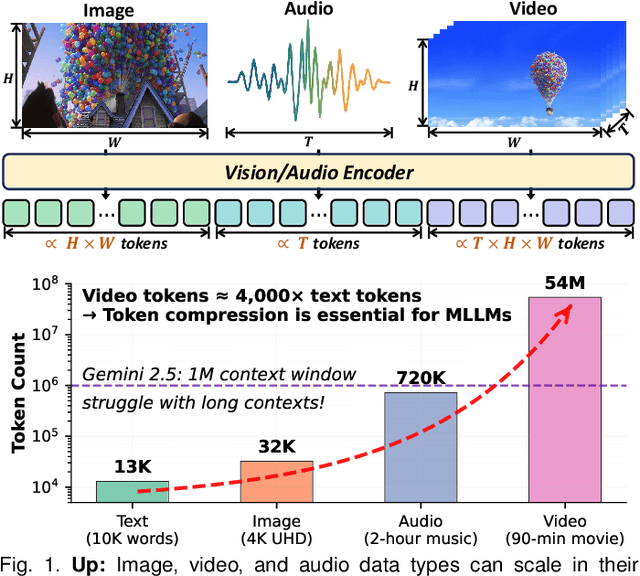
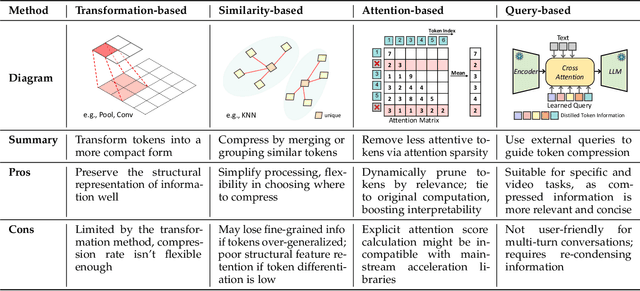
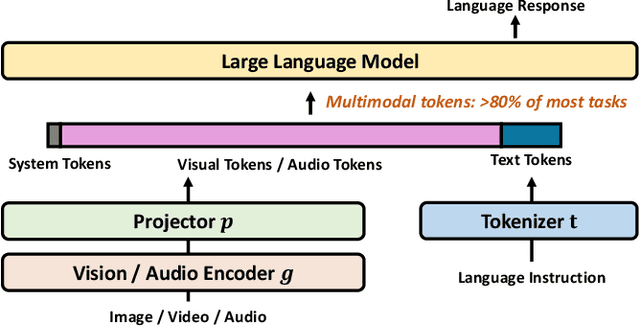
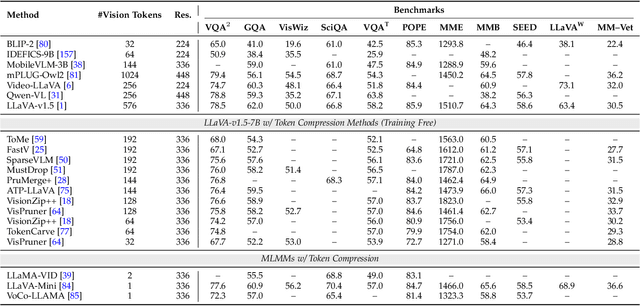
Abstract:Multimodal large language models (MLLMs) have made remarkable strides, largely driven by their ability to process increasingly long and complex contexts, such as high-resolution images, extended video sequences, and lengthy audio input. While this ability significantly enhances MLLM capabilities, it introduces substantial computational challenges, primarily due to the quadratic complexity of self-attention mechanisms with numerous input tokens. To mitigate these bottlenecks, token compression has emerged as an auspicious and critical approach, efficiently reducing the number of tokens during both training and inference. In this paper, we present the first systematic survey and synthesis of the burgeoning field of multimodal long context token compression. Recognizing that effective compression strategies are deeply tied to the unique characteristics and redundancies of each modality, we categorize existing approaches by their primary data focus, enabling researchers to quickly access and learn methods tailored to their specific area of interest: (1) image-centric compression, which addresses spatial redundancy in visual data; (2) video-centric compression, which tackles spatio-temporal redundancy in dynamic sequences; and (3) audio-centric compression, which handles temporal and spectral redundancy in acoustic signals. Beyond this modality-driven categorization, we further dissect methods based on their underlying mechanisms, including transformation-based, similarity-based, attention-based, and query-based approaches. By providing a comprehensive and structured overview, this survey aims to consolidate current progress, identify key challenges, and inspire future research directions in this rapidly evolving domain. We also maintain a public repository to continuously track and update the latest advances in this promising area.
Poison as Cure: Visual Noise for Mitigating Object Hallucinations in LVMs
Jan 31, 2025



Abstract:Large vision-language models (LVMs) extend large language models (LLMs) with visual perception capabilities, enabling them to process and interpret visual information. A major challenge compromising their reliability is object hallucination that LVMs may generate plausible but factually inaccurate information. We propose a novel visual adversarial perturbation (VAP) method to mitigate this hallucination issue. VAP alleviates LVM hallucination by applying strategically optimized visual noise without altering the base model. Our approach formulates hallucination suppression as an optimization problem, leveraging adversarial strategies to generate beneficial visual perturbations that enhance the model's factual grounding and reduce parametric knowledge bias. Extensive experimental results demonstrate that our method consistently reduces object hallucinations across 8 state-of-the-art LVMs, validating its efficacy across diverse evaluations.
ZhoBLiMP: a Systematic Assessment of Language Models with Linguistic Minimal Pairs in Chinese
Nov 09, 2024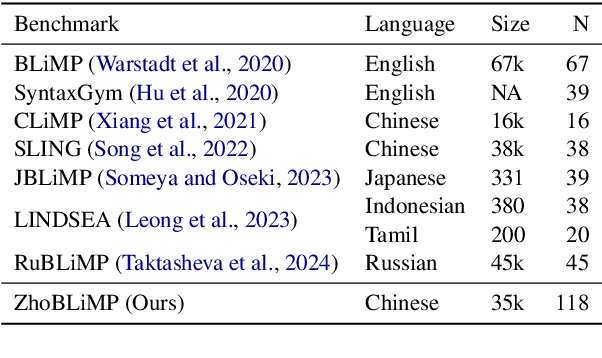

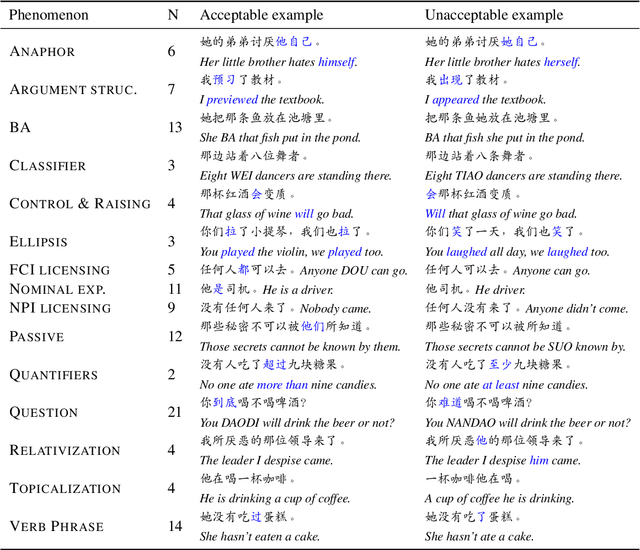
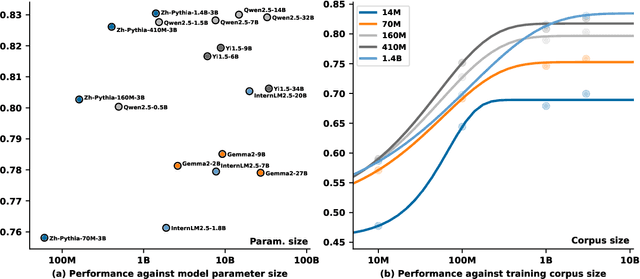
Abstract:Whether and how language models (LMs) acquire the syntax of natural languages has been widely evaluated under the minimal pair paradigm. However, a lack of wide-coverage benchmarks in languages other than English has constrained systematic investigations into the issue. Addressing it, we first introduce ZhoBLiMP, the most comprehensive benchmark of linguistic minimal pairs for Chinese to date, with 118 paradigms, covering 15 linguistic phenomena. We then train 20 LMs of different sizes (14M to 1.4B) on Chinese corpora of various volumes (100M to 3B tokens) and evaluate them along with 14 off-the-shelf LLMs on ZhoBLiMP. The overall results indicate that Chinese grammar can be mostly learned by models with around 500M parameters, trained on 1B tokens with one epoch, showing limited benefits for further scaling. Most (N=95) linguistic paradigms are of easy or medium difficulty for LMs, while there are still 13 paradigms that remain challenging even for models with up to 32B parameters. In regard to how LMs acquire Chinese grammar, we observe a U-shaped learning pattern in several phenomena, similar to those observed in child language acquisition.
Towards Adversarial Robustness via Debiased High-Confidence Logit Alignment
Aug 12, 2024



Abstract:Despite the significant advances that deep neural networks (DNNs) have achieved in various visual tasks, they still exhibit vulnerability to adversarial examples, leading to serious security concerns. Recent adversarial training techniques have utilized inverse adversarial attacks to generate high-confidence examples, aiming to align the distributions of adversarial examples with the high-confidence regions of their corresponding classes. However, in this paper, our investigation reveals that high-confidence outputs under inverse adversarial attacks are correlated with biased feature activation. Specifically, training with inverse adversarial examples causes the model's attention to shift towards background features, introducing a spurious correlation bias. To address this bias, we propose Debiased High-Confidence Adversarial Training (DHAT), a novel approach that not only aligns the logits of adversarial examples with debiased high-confidence logits obtained from inverse adversarial examples, but also restores the model's attention to its normal state by enhancing foreground logit orthogonality. Extensive experiments demonstrate that DHAT achieves state-of-the-art performance and exhibits robust generalization capabilities across various vision datasets. Additionally, DHAT can seamlessly integrate with existing advanced adversarial training techniques for improving the performance.
A Reference-free Metric for Language-Queried Audio Source Separation using Contrastive Language-Audio Pretraining
Jul 06, 2024



Abstract:Language-queried audio source separation (LASS) aims to separate an audio source guided by a text query, with the signal-to-distortion ratio (SDR)-based metrics being commonly used to objectively measure the quality of the separated audio. However, the SDR-based metrics require a reference signal, which is often difficult to obtain in real-world scenarios. In addition, with the SDR-based metrics, the content information of the text query is not considered effectively in LASS. This paper introduces a reference-free evaluation metric using a contrastive language-audio pretraining (CLAP) module, termed CLAPScore, which measures the semantic similarity between the separated audio and the text query. Unlike SDR, the proposed CLAPScore metric evaluates the quality of the separated audio based on the content information of the text query, without needing a reference signal. Experimental results show that the CLAPScore metric provides an effective evaluation of the semantic relevance of the separated audio to the text query, as compared to the SDR metric, offering an alternative for the performance evaluation of LASS systems.
Mitigating Low-Frequency Bias: Feature Recalibration and Frequency Attention Regularization for Adversarial Robustness
Jul 04, 2024Abstract:Ensuring the robustness of computer vision models against adversarial attacks is a significant and long-lasting objective. Motivated by adversarial attacks, researchers have devoted considerable efforts to enhancing model robustness by adversarial training (AT). However, we observe that while AT improves the models' robustness against adversarial perturbations, it fails to improve their ability to effectively extract features across all frequency components. Each frequency component contains distinct types of crucial information: low-frequency features provide fundamental structural insights, while high-frequency features capture intricate details and textures. In particular, AT tends to neglect the reliance on susceptible high-frequency features. This low-frequency bias impedes the model's ability to effectively leverage the potentially meaningful semantic information present in high-frequency features. This paper proposes a novel module called High-Frequency Feature Disentanglement and Recalibration (HFDR), which separates features into high-frequency and low-frequency components and recalibrates the high-frequency feature to capture latent useful semantics. Additionally, we introduce frequency attention regularization to magnitude the model's extraction of different frequency features and mitigate low-frequency bias during AT. Extensive experiments showcase the immense potential and superiority of our approach in resisting various white-box attacks, transfer attacks, and showcasing strong generalization capabilities.
Harmonizing Feature Maps: A Graph Convolutional Approach for Enhancing Adversarial Robustness
Jun 17, 2024



Abstract:The vulnerability of Deep Neural Networks to adversarial perturbations presents significant security concerns, as the imperceptible perturbations can contaminate the feature space and lead to incorrect predictions. Recent studies have attempted to calibrate contaminated features by either suppressing or over-activating particular channels. Despite these efforts, we claim that adversarial attacks exhibit varying disruption levels across individual channels. Furthermore, we argue that harmonizing feature maps via graph and employing graph convolution can calibrate contaminated features. To this end, we introduce an innovative plug-and-play module called Feature Map-based Reconstructed Graph Convolution (FMR-GC). FMR-GC harmonizes feature maps in the channel dimension to reconstruct the graph, then employs graph convolution to capture neighborhood information, effectively calibrating contaminated features. Extensive experiments have demonstrated the superior performance and scalability of FMR-GC. Moreover, our model can be combined with advanced adversarial training methods to considerably enhance robustness without compromising the model's clean accuracy.
CTS: A Consistency-Based Medical Image Segmentation Model
May 15, 2024Abstract:In medical image segmentation tasks, diffusion models have shown significant potential. However, mainstream diffusion models suffer from drawbacks such as multiple sampling times and slow prediction results. Recently, consistency models, as a standalone generative network, have resolved this issue. Compared to diffusion models, consistency models can reduce the sampling times to once, not only achieving similar generative effects but also significantly speeding up training and prediction. However, they are not suitable for image segmentation tasks, and their application in the medical imaging field has not yet been explored. Therefore, this paper applies the consistency model to medical image segmentation tasks, designing multi-scale feature signal supervision modes and loss function guidance to achieve model convergence. Experiments have verified that the CTS model can obtain better medical image segmentation results with a single sampling during the test phase.
MambaDFuse: A Mamba-based Dual-phase Model for Multi-modality Image Fusion
Apr 12, 2024



Abstract:Multi-modality image fusion (MMIF) aims to integrate complementary information from different modalities into a single fused image to represent the imaging scene and facilitate downstream visual tasks comprehensively. In recent years, significant progress has been made in MMIF tasks due to advances in deep neural networks. However, existing methods cannot effectively and efficiently extract modality-specific and modality-fused features constrained by the inherent local reductive bias (CNN) or quadratic computational complexity (Transformers). To overcome this issue, we propose a Mamba-based Dual-phase Fusion (MambaDFuse) model. Firstly, a dual-level feature extractor is designed to capture long-range features from single-modality images by extracting low and high-level features from CNN and Mamba blocks. Then, a dual-phase feature fusion module is proposed to obtain fusion features that combine complementary information from different modalities. It uses the channel exchange method for shallow fusion and the enhanced Multi-modal Mamba (M3) blocks for deep fusion. Finally, the fused image reconstruction module utilizes the inverse transformation of the feature extraction to generate the fused result. Through extensive experiments, our approach achieves promising fusion results in infrared-visible image fusion and medical image fusion. Additionally, in a unified benchmark, MambaDFuse has also demonstrated improved performance in downstream tasks such as object detection. Code with checkpoints will be available after the peer-review process.
Synth-AC: Enhancing Audio Captioning with Synthetic Supervision
Sep 18, 2023Abstract:Data-driven approaches hold promise for audio captioning. However, the development of audio captioning methods can be biased due to the limited availability and quality of text-audio data. This paper proposes a SynthAC framework, which leverages recent advances in audio generative models and commonly available text corpus to create synthetic text-audio pairs, thereby enhancing text-audio representation. Specifically, the text-to-audio generation model, i.e., AudioLDM, is used to generate synthetic audio signals with captions from an image captioning dataset. Our SynthAC expands the availability of well-annotated captions from the text-vision domain to audio captioning, thus enhancing text-audio representation by learning relations within synthetic text-audio pairs. Experiments demonstrate that our SynthAC framework can benefit audio captioning models by incorporating well-annotated text corpus from the text-vision domain, offering a promising solution to the challenge caused by data scarcity. Furthermore, SynthAC can be easily adapted to various state-of-the-art methods, leading to substantial performance improvements.
 Add to Chrome
Add to Chrome Add to Firefox
Add to Firefox Add to Edge
Add to Edge